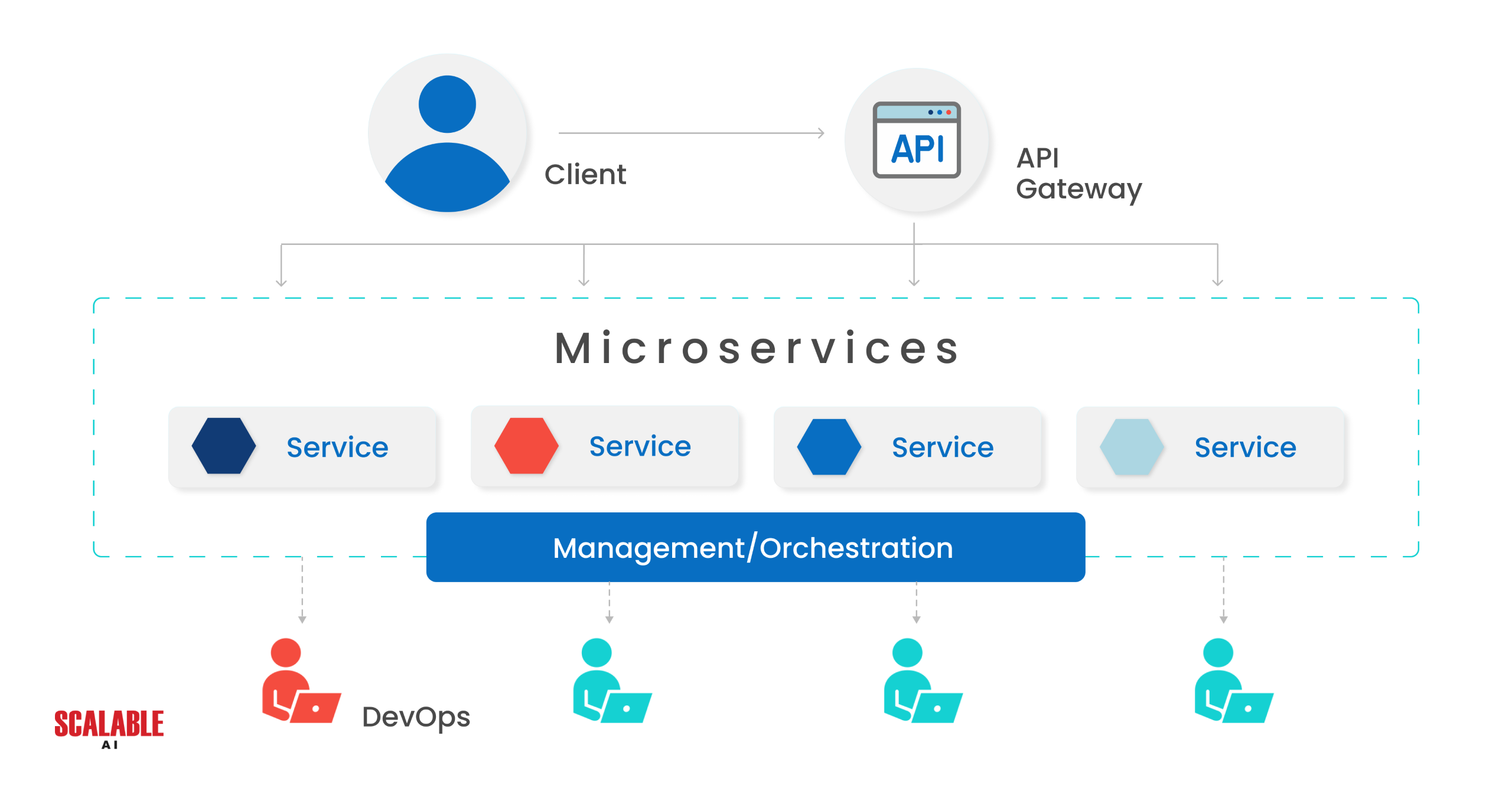To stay ahead in the present competitive market, software development requires agility, speed, and scalability. Traditional monolithic architectures often fall short in delivering these, leading to bottlenecks in development and deployment processes. Enter microservices — a game-changing approach that breaks down large, complex applications into smaller, independent services. When combined with Continuous Integration/Continuous Deployment (CI/CD), microservices become a powerhouse, enabling faster and more flexible development cycles. In this blog, we’ll explore how microservices and CI/CD work together to eliminate bottlenecks and enhance Agile development.
Understanding Microservices Architecture
Microservices architecture is a design paradigm where large software applications are decomposed into smaller, loosely coupled services. Each service is designed to perform a specific function and can be developed, tested, and deployed independently. This modularity offers several advantages:
- Scalability: Microservices can scale independently based on demand, allowing for more efficient resource allocation.
- Flexibility: Different microservices can be built using different programming languages and technologies, providing development teams with greater flexibility.
- Faster Time-to-Market: With smaller components, microservices enable quicker iteration and deployment, enhancing the speed of development cycles.

The Synergy Between Microservices and CI/CD
CI/CD refers to the automated process of integrating code changes, testing them, and deploying them into production. The combination of microservices and CI/CD creates a powerful framework for agile software development, offering a seamless approach to integrating and deploying code. Here’s how they complement each other:
- Independent Deployment: Since microservices are independent entities, they can be updated or deployed without affecting other services. CI/CD automates this process, enabling continuous and rapid deployment of updates.
- Automated Testing: CI/CD pipelines include rigorous testing stages, ensuring that microservices function as expected. Automated testing is crucial in microservices, where frequent updates can lead to inconsistencies if not tested thoroughly.
- Parallel Development: With microservices, different teams can work on various services simultaneously. CI/CD automates integration, ensuring that all parts of the application continue to work together despite independent development.
How Microservices and CI/CD Eliminate Bottlenecks
Microservices and CI/CD eliminate several common bottlenecks in traditional software development by decoupling services and automating integration and deployment.
Faster Development Cycles
In traditional monolithic architectures, a single change requires testing and redeploying the entire application. This not only slows down the process but increases the likelihood of bugs slipping through. Microservices, with their modular nature, allow for independent updates. With CI/CD, developers can automatically test and deploy individual services without needing to redeploy the entire system, significantly speeding up development cycles.
Scalability and Flexibility
Monolithic applications struggle with scaling, as they require scaling the entire application, even if only one part needs more resources. Microservices, on the other hand, can scale independently. CI/CD supports this scalability by automating deployments to different environments and orchestrating resource allocation, allowing for dynamic scaling based on demand.
Increased Reliability
When an application is divided into microservices, failures in one service don’t necessarily affect the entire application. CI/CD further enhances reliability by automatically testing services before deployment. This ensures that only stable and functional code is integrated into production, reducing the risk of introducing bugs into the system.
Improved Collaboration and Efficiency
Microservices enable different teams to work on various components of an application simultaneously, improving collaboration and efficiency. With CI/CD, the process of integrating these changes is automated, reducing the need for manual intervention and eliminating bottlenecks caused by code conflicts or integration issues.
Building an Efficient CI/CD Pipeline for Microservices
Creating a robust CI/CD pipeline is key to leveraging the benefits of microservices. Here’s how to build an efficient pipeline:
Modularity
Since microservices are inherently modular, your CI/CD tools should support this architecture. Ensure the tools allow for parallel builds and testing, aligning with the independent nature of microservices.
Automated Testing
A well-defined testing strategy is crucial for microservices. Include unit testing for individual services, integration testing to check service interactions, and code analysis to assess quality and security. Automated tests ensure that new changes don’t introduce bugs or degrade performance.
Version Control Integration
Integrating CI/CD pipelines with your version control system streamlines the workflow. Configure the pipeline to trigger builds and tests automatically upon changes in the version control system, ensuring quick feedback and preventing faulty code from entering the main branch.
Containerization and Orchestration
Microservices often run in containerized environments. Leverage containerization tools like Docker to package microservices with their dependencies, ensuring consistency across environments. Orchestration tools like Kubernetes can manage the deployment and scaling of these containers efficiently.
Rolling Deployments
Rolling deployments allow updates to be progressively rolled out across microservices, ensuring minimal downtime and reduced risk of deployment failures. CI/CD tools should support rolling deployments, enabling a smoother transition from one version of a service to the next.
Post-Deployment: Monitoring and Feedback
After deployment, continuous monitoring is essential to ensure the microservices function optimally in production. Integrate real-time monitoring tools into your CI/CD pipeline to track performance, identify anomalies, and trigger alerts when necessary. Monitoring helps maintain a high level of performance and reliability, essential in dynamic microservices environments.
Additionally, having well-defined rollback strategies in place ensures quick recovery from unforeseen issues. With microservices and CI/CD, rolling back a specific service to a stable version is faster and less disruptive than with monolithic architectures.
Conclusion
The combination of microservices and CI/CD transforms the way software is developed and deployed, offering unprecedented flexibility, speed, and scalability. By breaking down applications into smaller, manageable components, microservices remove bottlenecks associated with monolithic architectures. When paired with CI/CD, they automate integration, testing, and deployment, enabling faster development cycles and improving collaboration across teams.
As businesses continue to demand faster time-to-market and more agile development processes, adopting microservices and CI/CD is essential for staying competitive. Embrace this powerful duo to eliminate bottlenecks, accelerate innovation, and deliver high-quality software with greater efficiency.
Read Whitepaper Microservices Disruption: Transforming Business with Agility
